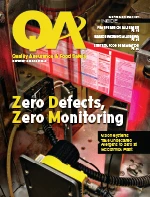Some people are convinced they do not need a sanitizer following washing because they instead allow for air drying. But the fact is: If one washes, then one must sanitize. A rule of thumb is that dry material equipment should be dry cleaned and semi-moist or wet material equipment should be washed and sanitized.
To sanitize or not to sanitize is the question. So why should we sanitize?
Simply put, cleaning prepares a surface for sanitizing to kill microorganisms. If the surface is not clean, that surface cannot be effectively sanitized. The application of sanitizers to dirty surfaces is ineffective. In food plant operations, the type of food being processed will determine a cleaning regimen.
Wet Cleaning. Wet cleaning is necessary to remove fats, proteins, carbohydrates, sugars, or a combination of these.
Seven basic steps in washing and sanitizing hold true for most soil removal in food processing systems, equipment, and wet-designed areas:
- Inspect the area for the task and remove large soil accumulations using dry cleaning techniques.
- Flush or sweep soil from the surface with water of an appropriate temperature.
- Use the appropriate cleaner and method to clean the surface. It may be necessary to scrub some areas to remove stubborn soils. Foamers are good for areas with difficult soil buildup.
- Flush the cleaner from the surface with water at an appropriate temperature.
- Apply the appropriate sanitizer following label directions. This is often best conducted with a misting method. Double check no-rinse sanitizers for proper use concentrations on food-contact surfaces.
- Dry and dehumidify the area. Note: Keeping an area dry, even in a designed wet zone, will prevent or delay microbial growth.
- Perform an organoleptic inspection (validate) and conduct cleaning microbial evaluation, such as, with the use of swabs (verify).
The removal of excess soil is an important step in this process. Sending large soil accumulations to the drain, especially with high pressure washing, is full of problems. The type of cleaner must be effective against the soil in question. What works in one situation for a specific soil may not work for all. The same holds true for the type of sanitizer and also its application method.
Dry Cleaning. Not all operations should be wet cleaned. Dry blending plants, flour mills, and grain processing facilities are such operations. Bakeries and dry pet food plants are two examples of wet clean areas within a vast dry cleaning operation. Vacuum systems are excellent equipment for dry cleaning. These systems should be maintained and kept clean so they themselves are not a source of microbial and/or insect contamination. Flour mills and grain processing facilities with well-designed central vacuum systems are cleaner and more insect-free operations.
|
Idea building is a powerful technique during brainstorming activity. Thinking on a fundamentally sound idea will lead to better solutions. Using front line workers dealing directly with a problem also leads to better solutions by building on one idea with floor level buy-in. Auditor's Soapbox |
Good sanitary design provides that specific areas be washed, while other areas not be washed. That is, wet cleaning a dry-clean-designed zone will provide conducive conditions for microbial growth, such as hidden, moist debris in, under, and around supporting framework. Dry cleaning a wet-clean-designed zone will also provide conducive conditions for microbial growth, such as that of unused drains. In such cases, insect activity, such as that of drain flies (moth flies), actually can help one find a problematic microbial source.
The selection of a sanitizer depends upon the surface and microbes encountered. A variety of sanitizers are available. A compound made up of an alcohol (long recognized as an optimal sanitizing agent) and a four-chain quaternary ammonium (which continues sanitizing after the alcohol has evaporated) provides for an effective approach in most food plant operations.
Periodically rotating sanitizers is recommended. In some applications, one could sterilize problematic “hot spots” with heat (320°F) for a few hours. This approach can be damaging to processing equipment, but it can be used in microbial problematic areas, such as some product coolers.
Conclusion. Sanitizing is the application of a chemical to a clean surface to kill microorganisms, without adversely affecting the food product or its safety for the consumer. So why should a sanitizer be used? Sanitizing offers health benefits by killing microorganisms on surfaces. Killing microorganisms in a food processing plant is a big challenge and comes with high risk if not done properly. Cleaning to prepare a surface for sanitizing, yet not sanitizing, might be like applying shaving cream and not shaving. Pathogens such as Salmonella are a beast. We must control them using all the tools in the microbial toolbox, and sanitizers are some mighty big tools.

Explore the December 2012 Issue
Check out more from this issue and find your next story to read.
Latest from Quality Assurance & Food Safety
- Chef Robotics Introduces Pat-Down Capability for Meal Presentation and Sealing
- USDA Launches Regenerative Pilot Program
- Indoor Ag-Con Adds Food Safety Track to Conference Lineup
- IDFA Recognizes Federal Officials for Support of U.S. Dairy Industry
- Tetra Pak Acquires Bioreactors.net
- Fresh Del Monte Receives Rabobank Leadership Award
- São Paulo Earns Guinness World Record for Largest Municipal Food Security Program
- KPM Analytics Releases Ready-to-Use NIR Calibration Packages





